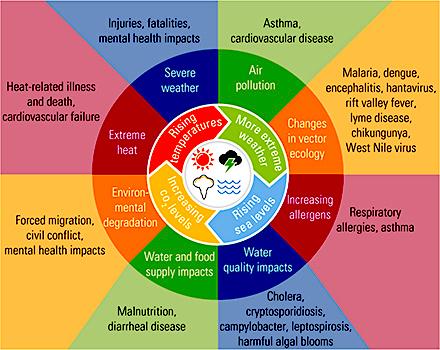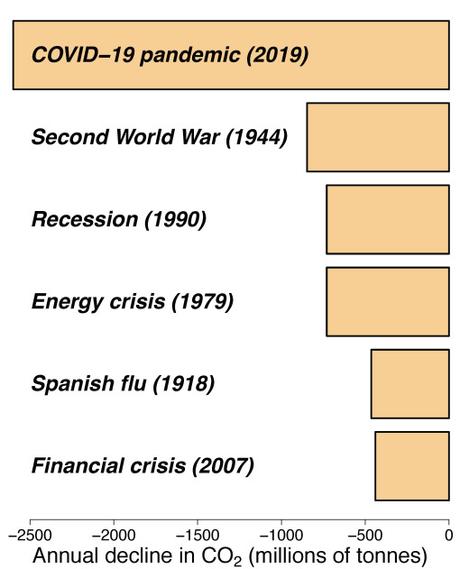Both anthropogenic climate change and the coronavirus pandemic entail serious health risks. Why then do climatologists lack the public credibility and political repercussions that doctors have? Preventing the aggravation of the climate emergency is possible if we react to it in the same way we are reacting to the pandemic, essentially, following the advice of the scientific community.
We have as much uncertainty regarding the coronavirus COVID-19 that causes acute respiratory failure (SARS-CoV-2) as we do about human-made greenhouse gases causing climate change.
Both problems are currently costing (and will cost) trillions to national economies. But the main difference between the two when it comes to public perception is not economic but temporal. The virus has changed our lives in days to months whereas climate change is taking years to decades to do so. This short-termism about how we respond to the pace of an emergency has been sculped in our genes by evolution (1) and contaminates politics.
Early this year, after deriding the onset of the pandemic, many climate change-denialist leaders (the obvious picks are Trump, Bolsonaro, and Johnson [note that Johnson modified his public views on climate change when becoming UK foreign secretary in 2016]) had to swallow their own words and honor their political profession when human corpses started to pile up in their hospitals.

Impacts of climate change on human health. Two notorious examples are the heatwave that soared Europe in 2003 resulting in 70,000 deaths or the 8 million who perish annually due to air contamination. Furthermore, climate warming lengthens the annual prevalence of vector-borne diseases like malaria, which kills 700,000 people every year. All entails an average health cost of US$3 billion/year, excluding the gigantic expenses originating from wars and migrations instigated by climate-driven reduction in water and food availability (9, 10). The difference in the health bill between a planet warming up to 1.5 versus 2.0 °C by 2030 relative to pre-industrial levels (4) implies a 1-2% of the gross domestic product of the European Union alone. This figure is courtesy of George Luber. Luber is an epidemiologist and former Chief of the Climate and Health Program gradually being dismantled by the Trump Administration. Shortly after Trump irrupted in the White House in 2016, Luber was banned from using the expression ‘climate change’ publicly and from accessing the premises where he works (listen to his speech impressively mingled with sarcasm and realism and to both sides of the story leading to legal proceedings). Can you imagine that, during the ongoing pandemic, a health authority in your country could not access his/her hospital to work or pronounce ‘covid’ in a press conference?
But simple games of words suffice to negate climate change from presidential palaces or business skyscrapers when no immediate deaths can be seen on the horizon. If a mask-wearing school teacher living in Barrio de Salamanca (one of Madrid’s wealthiest suburbs) can negate COVID-19’s lethality because she has not seen coffins or autopsies with her own eyes, arguing the non-existence of global warming, the melting of the poles, ocean acidification, or sea level rise is a no-brainer.
Listening to science
It does not stand to reason why a doctor is more credible than a climatologist.
We know why global pandemics and climate change occur. Our planet is over-populated, over-connected, and over-exploited. We destroy forests and so expose ourselves to pathogens that have coexisted with wild animals within those forests for millennia (2). When the pathogens jump to our bodies (zoonosis), they have ~ 8 billion human beings susceptible to be infected and thousands of aerial highways to cross the planet in one single day (3).
The coronavirus crisis is a logical and natural outcome from ecological and demographic principles. Likewise, every year we dump > 40 billion tonnes of carbon dioxide into the atmosphere (4). Already in the 19th Century, John Tyndall and Svante Arrhenius theorised and tested that greenhouse gases absorb heat. They were the first to conceptualise that the Earth reflects a fraction of the sun’s heat to the atmosphere, and greenhouse gases bounce it back to the Earth eliciting oceanic and atmospheric warming — the greenhouse effect (5). More greenhouse gases mean more warming (among other multiple effects).
Global warming is a logical and natural outcome from physical and climatic principles.
Doctors of climate
During the COVID-19 pandemic, the scientific community has impersonated Mafalda (the ingenious schoolgirl created by the great cartoonist Quino). In one the classical scenes depicting Mafalda’s harangue about human misconduct and injustice, she questions a globe mutely standing in the lounge of a working-class house. “Politicians, business-(wo)men, citizens: we had already told you! Scientists have been sending warnings about the prospects of global pandemics and climate disruption for decades now.”
In our country, over and over again in the last few months, we have heard politicians speaking up the mantra that, had we known about the severity of COVID-19 from the beginning, we would have acted differently.
OK then. We already have that information about climate change, we don’t need more science. However, the COVID-19 type of mantra seems non-applicable to climate change. And, year after year, the economic, health and environmental costs and risks inflicted by climate change and environmental destruction keep multiplying (6).
If scientists are the doctors of climate, as much as they are of the COVID-19 pandemic, we challenge our common sense by blindly trusting those professionals who investigate the health of the human body, but not those that investigate the health of the planet. The object of study is different, but the scientific method is identically the same.

Declines* in human-made greenhouse-gas emissions in six recent global crises. By the end of 2020, our greenhouse emissions are expected to decline globally by 8% relative to 2019, a historical record triggered by the economic recession caused by COVID-19 (11). This annual reduction is the rate required from now to 2030 to avoid 1.5 °C warming relative to pre-industrial levels (12). The costs and risks of failing to meet that goal have already been written and are publicly available on the International Panel on Climate Change’s (IPCC) website (4). Paradoxically, the Government of Spain has just sent to Las Cortes the first (draft) law addressing climate change and energetic transition (Primer Proyecto de Ley de Cambio Climático y Transición Energética) that states that, by 2030, Spanish economic activities will reduce their greenhouse-gas emissions by 20% relative to 1990 national emissions, that is, ~ 3% annually. Those numbers do not add up to the IPCC’s recommendations. This is as if, in response to the advice of health authorities of keeping two metres of interpersonal distance and staying at home to prevent COVID-19 transmissions, we convened wild and crowded parties every day. Citizens are being fined for not observing social distancing and could go to jail if their behavior caused the spread of the disease and the death of other citizens. Then, who is to be fined for not complying with the recommendations of international climate authorities? Who is to be held liable for future climate-driven casualties that could be avoided by reducing green-house emissions now? Sources: www.carbonbrief.org and the International Energy Agency.
*Decline rates quantified one year before the end of Second World War or after the outbreak of the COVID-19 pandemic, the economic recession, the energy (oil) crisis, the Spanish flu and the financial crisis.
An opportunity to rectify
Let’s ask scientists to engineer vaccines and cures for diseases and environmental problems, because we already have the technological prowess to abate them. And let’s ask politicians to invest in science in order to generate more knowledge.
But we cannot afford ignoring that the worst foreseeable future for our planet is to return to the ‘normality’ in which we have been long dwelling prior to the pandemic. Governments are currently investing heaps of money to pull through the ongoing economic recession, and 2008’s financial crisis had already taught us that politicians have ample leeway to decide in what sectors and under which formulas to make those investments (7).
We know now that the world does not end if the economy slows down … and we use the lapse as a stepping stone towards growing in a sustainable fashion. The conundrum we are in now represents an opportunity to lay the bases of a structural change in the way we produce energy and exploit natural resources with immediate revenue and new jobs (8).
Governments of the Earth, please listen to the scientific community and look into the future.
—
Salvador Herrando-Pérez and David R. Vieites
References
- Goymann, W. (2020). What the Corona (SARS-CoV 2) pandemic, climate change, and the biodiversity crisis teach us about human nature. Ethology 126: 593-594
- Allen, T. et al. (2017). Global hotspots and correlates of emerging zoonotic diseases. Nature Communications 8: 1124
- Gibbs, E.P.J. (2005). Emerging zoonotic epidemics in the interconnected global community. Veterinary Record, 157: 673-679
- IPCC (2018). Global Warming of 1.5 ºC. An IPCC Special Report on the impacts of global warming of 1.5°C above pre-industrial levels and related global greenhouse gas emission pathways, in the context of strengthening the global response to the threat of climate change, sustainable development, and efforts to eradicate poverty. Geneva, Switzerland.
- Letcher, T.M. (2019). Why do we have global warming?, in Managing Global Warming. (Academic Press, London, UK), pp. 3-15
- Lenton, T.M. et al. (2008). Tipping elements in the Earth’s climate system. Proceedings of the National Academy of Sciences of the USA 105: 1786-1793
- Strand, J. & Toman, M. (2010). “Green stimulus,” economic recovery and long-term sustainable development. Policy Research Working Paper, 5163. The World Bank Development Research Group Environment and Energy Team. 171 pages
- Hanna, R. et al. (2020). After COVID-19, green investment must deliver jobs to get political traction. Nature 582: 178-180
- Abel, G.J. et al. (2019). Climate, conflict and forced migration. Global Environmental Change 54: 239-249
- Bowles, D.C. et al. (2015). Climate change, conflict and health. Journal of the Royal Society of Medicine 108: 390-395
- International Energy Agency (2020). Global Energy Review 2020: the impacts of the Covid-19 crisis on global energy demand and CO2 emissions. 53 pages
- United Nations Environment Programme (2019). Emissions Gap Report. Nairobi (Kenya): 81 pages

